O METAMORFISMO NA IGREJA DE NOSSA SENHORA DE FÁTIMA
PORTUGUÊS
AS ROCHAS!

As rochas podem ser classificadas de acordo com sua composição química, a sua forma estrutural, ou a sua textura, sendo mais comum classificá-las de acordo com os processos da sua formação.
Pelas suas origens ou maneiras como foram formadas, as rochas são classificadas como ígneas (ou magmáticas), sedimentares, e metamórficas.
As rochas ígneas (ou magmáticas) são o resultado da solidificação e consolidação do magma.
As sedimentares formaram-se pela deposição de sedimentos e posterior compressão destes.
As rochas metamórficas eram inicialmente ígneas ou sedimentares que posteriormente foram modificadas pelos efeitos de temperatura e pressão
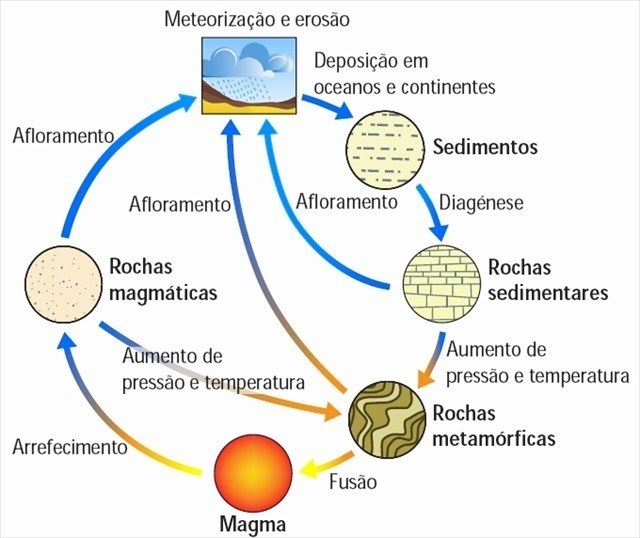
Metamorfismo
O metamorfismo (mudança de forma) constitui a transformação de uma rocha preexistente, que pode ser ígnea, sedimentar ou metamórfica.
Os agentes de transformação ou de metamorfismo incluem o calor, pressão e fluidos quimicamente activos, que produzem modificações de textura e composição mineral.
O metamorfismo pode ocorrer com um grau de baixa intensidade fazendo com que por vezes seja difícil distinguir a rocha original da final. Noutros casos a transformação é tão intensa que não é possível identificar a rocha de origem. No metamorfismo de grau elevado, características estruturais tais como planos de estratificação, fósseis e espaços vazios vesiculares, que poderiam existir na rocha original são completamente destruídas. É importante referir que durante os processos de metamorfismo de grau elevado a rocha mantém-se sempre no estado sólido porque, uma vez atingida a fusão desta entra-se num processo de natureza ígnea.
Tipos de Metamorfismo
O processo de metamorfismo inicia-se quando uma rocha é submetida a condições diferentes daquelas em que se formou originalmente. A rocha começa então a sofrer transformações até atingir um estado de equilíbrio com o novo ambiente. Estas modificações ocorrem a profundidades a partir de alguns quilómetros até próximo da fronteira entre a crusta e o manto. A formação de rochas metamórficas ocorre em zonas completamente inacessíveis ao contrário de muitas rochas sedimentares e algumas ígneas, daí o seu estudo ser mais difícil.
O metamorfismo pode ser de três tipos:
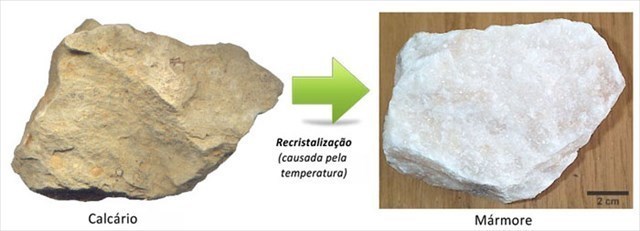
Metamorfismo Regional-Ocorre na formação de cadeias de montanhas quando grandes quantidades de rochas são submetidas a tensões de elevada intensidade e altas temperaturas associadas com os grandes níveis de deformação;
Metamorfismo de Contacto ou Térmico -Sucede quando a rocha fica perto ou em contacto com uma massa de magma quente, onde as altas temperaturas são a causa primária das transformações das rochas encaixantes;
Metamorfismo Dinâmico ou Cataclástico - Ocorre quando a rocha é submetida a pressões muito elevadas e bruscas como por exemplo em zonas de falhas.
Metamorfismo de Contacto
Quando o magma ascende e entra em contacto com outras rochas (também chamadas rochas encaixantes), vai provocar o seu aquecimento. A área que é aquecida em torno do magma constitui uma auréola de metamorfismo. Nessa zona, o aumento de temperatura provoca uma recristalização dos minerais da rocha encaixante. Algo de semelhante ao que acontece com a consolidação das rochas magmáticas, mas como a temperatura não é tão elevada, os cristais aumentam de tamanho mas a rocha nunca chega a fundir completamente.
A zona de contacto de metamorfismo, também denominada auréola de metamorfismo, é relativamente estreita, geralmente com 1 a 50 metros de largura. Uma intrusão de pequeno volume, como, por exemplo, um dique, pode descorar e endurecer as rochas encaixantes numa zona de alguns centímetros a partir do contacto, enquanto uma grande intrusão magmática pode originar uma auréola de grande superfície. Isto acontece devido ao tempo que a massa demora a arrefecer. Uma massa pequena, como um dique arrefece muito mais rapidamente do que uma massa grande como por exemplo, um batólito.
A natureza litológica das rochas formadas depende da natureza litológica do terreno encaixante.
Como no metamorfismo de contacto a pressão é pouco significativa, o fenómeno ocorre sem deformação.
O mármore (originado a partir do calcário) é um bom exemplo de uma rocha formada por este processo. Por sua vez a argilite transforma-se em ardósia.
Durante o metamorfismo de contacto, as rochas calcárias originam mármores, desde que sujeitas a condições de metamorfismo adequados de forma a recristalizar a calcite em grãos com dimensão igual ou quase.
O mármore tem origem no calcário, que foi recristalizado por contacto com uma intrusão magmática. O carbonato de cálcio (calcite) recristaliza, originando uma estrutura cristalina e compacta. Os mármores puros são brancos. Quando os mármores apresentam cor significa que existem impurezas.
BIOTURBAÇÃO
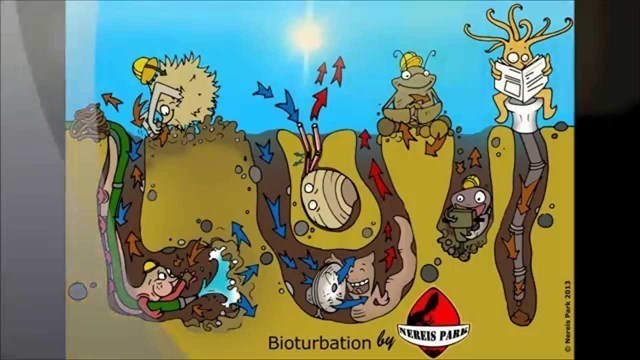
Bioturbação é a reformulação de solos e sedimentos por animais ou plantas. Os seus efeitos incluem mudanças texturais, mudança de sedimentos (diagenético), bioirrigaçao e deslocamento de microorganismos e partículas não-vivas.

PERGUNTAS/RESPOSTAS
Para “encontrar/registar” esta cache deverá: provar que esteve no local e responder às seguintes questões, enviando um email/mensagem de Geocaching, com as respostas, em português ou em inglês, para o nosso perfil.
Só depois, de enviar as respostas, e conforme as “guidelines” para as Earthcaches, deverá efectuar o seu registo!
Serão removidos todos os registos que não obedeçam a estes requisitos. O owner desta earthcache só contactará consigo se existir algum problema com as suas respostas.

1. A partir das informações constantes do listning desta earthcache, procura responder às seguintes questões:
a) Explica, por palavras tuas, o que é o metamorfismo.
b) Através de metamorfismo, em que rocha se transforma a argilite?
c) E em que rocha se transforma, por metamorfismo, o calcário?
d) Explica o que são “vergadas”?
e) Existe evidência clara de bioturbação?
2. Procura responder às seguintes questões a partir das tuas observações efectuadas no GZ desta earthcache (GZ situado em frente da porta principal – sul – deste templo). Observa a fachada/parede desta igreja, que se situa á direita, quem entra, da porta! Observa atentamente o bloco rectangular A2 (ver grelha)!
a) Consegues observar descontinuidades?
b) Quais as cores que consegues observar nesta rocha consolidada?
c) Existem impurezas nestas rochas?
d) Qual a granulometria observada em A2?
3. Poderás entrar no templo e a meio da nave principal (e única) desta igreja, deverás voltar-te para a porta principal (sul) e observar a “grande janela” constituída por 28 janelas rectangulares.
a) Observando a janela B1 (consultar a grelha), diz: a) se são visíveis, ou não, “vergadas”. b) Em caso afirmativo estas são horizontais ou verticais? c) No caso afirmativo, são contínuas ou descontínuas?
b) Qual o nome da rocha de que são formadas estas 28 janelas?
4.
TAREFA OBRIGATÓRIA:Deverá tirar uma foto sua, onde você apareça (ou com um papel/placa onde conste o seu nickname e a data da visita) e que comprove a sua presença no GZ desta EC - NÃO META SPOILERS. Esta foto deverá ser colocada no seu registo ou enviada por email ou sistema de mensagens de Geocaching, para o owner!


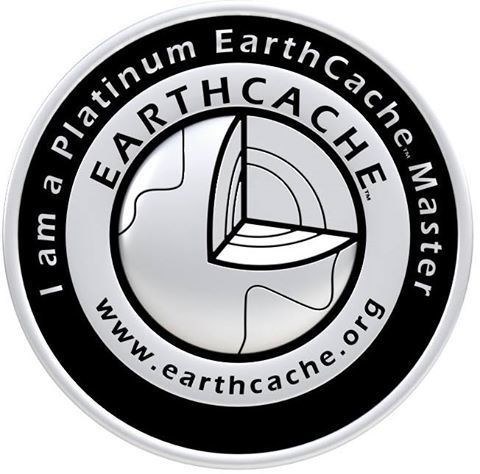
THE METAMORPHISM IN THE CHURCH OF OUR LADY OF FATIMA

ENGLISH


THE ROCKS!
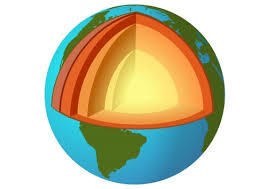
The rocks can be classified according to their chemical composition, their structural form, or their texture, being more common to classify them according to the processes of their formation.
By their origins or manners as they were formed, the rocks are classified as igneous (or magmatic), sedimentary, and metamorphic.
The igneous (or magmatic) rocks are the result of the solidification and consolidation of the magma.
Sediments were formed by deposition of sediments and subsequent compression of sediments.
The metamorphic rocks were initially igneous or sedimentary that later were modified by the effects of temperature and pressure.
Metamorphism
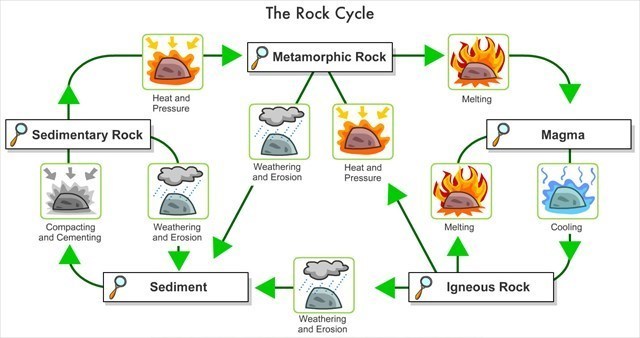
Metamorphism (change of shape) is the transformation of a preexisting rock, which can be igneous, sedimentary or metamorphic.
Transformation or metamorphism agents include heat, pressure and chemically active fluids, which produce modifications of texture and mineral composition.
The metamorphism can occur with a degree of low intensity making it sometimes difficult to distinguish the original rock from the final. In other cases the transformation is so intense that it is not possible to identify the original rock. In high-grade metamorphism, structural features such as stratification planes, fossils and vesicular void spaces that could exist in the original rock are completely destroyed. It is important to note that during high-grade metamorphism the rock is always in the solid state because once it is melted it enters a process of igneous nature.
Types of Metamorphism

The process of metamorphism begins when a rock is subjected to conditions different from those in which it originally formed. The rock then begins to undergo transformations until it reaches a state of equilibrium with the new environment. These changes occur at depths from a few kilometers to near the border between the crust and the mantle. The formation of metamorphic rocks occurs in completely inaccessible zones unlike many sedimentary rocks and some igneous, hence their study is more difficult.
The metamorphism can be of three types:
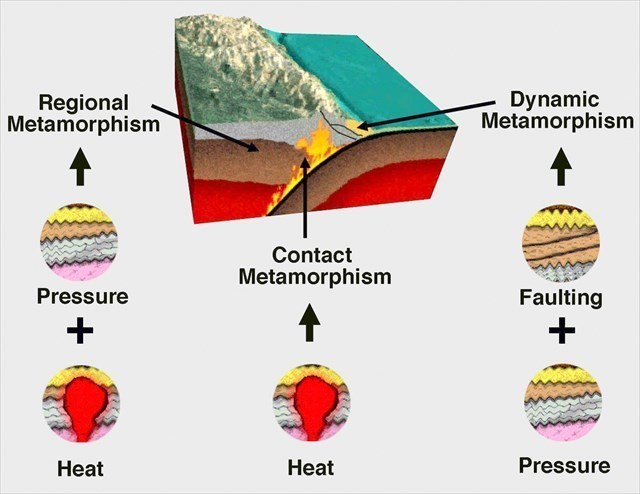
Regional Metamorphism - Occurs in the formation of mountain ranges when large amounts of rocks are subjected to high intensity voltages and high temperatures associated with high levels of deformation;
Contact or Thermal Metamorphism - Occurs when the rock is near or in contact with a mass of hot magma, where high temperatures are the primary cause of the transformations of the nesting rocks;
Dynamic or Cataclastic Metamorphism - Occurs when the rock is subjected to very high and sudden pressures, for example in areas of failure.
Contact Metamorphism
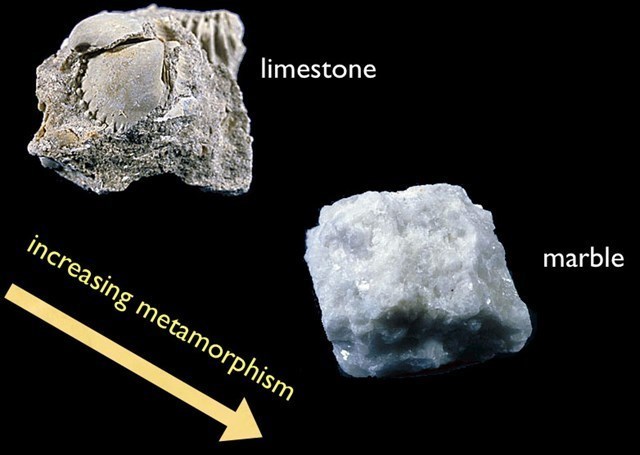
When the magma rises and comes in contact with other rocks (also called rocks), it will cause its heating. The area that is heated around the magma constitutes a halo of metamorphism. In this zone, the temperature increase causes a recrystallization of the minerals from the nesting rock. Something similar to what happens with the consolidation of magmatic rocks, but as the temperature is not so high, the crystals increase in size but the rock never quite melts completely.
The contact zone of metamorphism, also called the metamorphism halo, is relatively narrow, usually 1 to 50 meters wide. A small volume intrusion, such as a dyke, may bleach and harden the nesting rocks within a few centimeters of the contact, while a large magmatic intrusion may lead to a large surface aureole. This happens due to the time the mass takes to cool down. A small mass such as a dyke cools much faster than a large mass such as a batholith.
The lithological nature of the rocks formed depends on the lithological nature of the terrain.
As in contact metamorphism the pressure is not significant, the phenomenon occurs without deformation.
The marble (originated from the limestone) is a good example of a rock formed by this process. In turn the argillite turns into slate.
During contact metamorphism, limestone rocks originate marbles, provided they are subjected to suitable metamorphism conditions in order to recrystallize the calcite in grains of equal or near dimension.
The marble originates in the limestone, which was recrystallized by contact with a magmatic intrusion. Calcium carbonate (calcite) recrystallizes, giving a crystalline and compact structure. The pure marbles are white. When the marbles present color means that there are impurities.
BIOTURBATION

Bioturbationis defined as the reworking of soilsand sedimentsby animals or plants. These include burrowing, ingestion and defecation of sediment grains. Bioturbating activities have a profound effect on the environment and are thought to be a primary driver of biodiversity. The formal study of bioturbation began in the 1800s by Charles Darwinexperimenting in his garden. The disruption of aquatic sediments and terrestrial soils through bioturbating activities provides significant ecosystem services. These include the alteration of nutrientsin aquatic sediment and overlying water, shelter to other species in the form of burrows in terrestrial and water ecosystems, and soil production on land.

QUESTIONS
To "find / register" this cache should: prove that you were on the spot and respond to the following questions by sending an email / Geocaching message, with the answers, in Portuguese or English, to our profile.
Only then, to send the answers, and according to the guidelines for Earthcaches, you must register!
All records that do not meet these requirements will be removed. The owner of this earthcache will only contact you if there is a problem with your answers.
1. From the information in the listning of this earthcache, try to answer the following questions:
a) Explain, in your words, what is the metamorphism.
b) Through metamorphism, in what rock does argillite become?
c) And in what rock is the limestone transformed by metamorphism?
d) Explain what are "bends"?
e) Is there clear evidence of bioturbation?
2. Try to answer the following questions from your observations made in the GZ of this earthcache (GZ located in front of the main door - south - of this temple). Look at the facade / wall of this church, which is on the right, who enters, from the door! Look carefully at rectangular block A2 (see grid)!
a) Can you observe discontinuities?
b) What colors can you observe in this consolidated rock?
c) Are there impurities in these rocks?
d) What is the granulometry observed in A2?
4. You may enter the temple and in the middle of the main (and only) nave of this church, you should turn to the main door (south) and observe the "large window" consisting of 28 rectangular windows.
a) Observing window B1 (consult the grid), it says: a) whether or not "bends" are visible. b) If so, are they horizontal or vertical? c) If so, are they continuous or discontinuous?
b) What is the name of the rock from which these 28 windows are formed?
5.
TASK (not optional): You must take a picture of yourself, where do you show up, (or with a paper / plaque with your geocaching nickname and the date of the visit) and that proves your presence in the GZ of this EC - no spoilers please. This photo must be placed in your log or sent by email or Geocaching messaging system, to the owner!
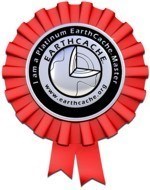


The most exciting way to learn about the Earth and its processes is to get into the outdoors and experience it first-hand. Visiting an Earthcache is a great outdoor activity the whole family can enjoy. An Earthcache is a special place that people can visit to learn about a unique geoscience feature or aspect of our Earth. Earthcaches include a set of educational notes and the details about where to find the location (latitude and longitude). Visitors to Earthcaches can see how our planet has been shaped by geological processes, how we manage the resources and how scientists gather evidence to learn about the Earth. To find out more click HERE.
